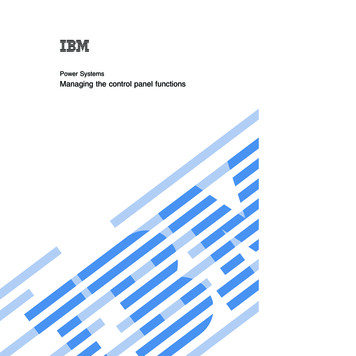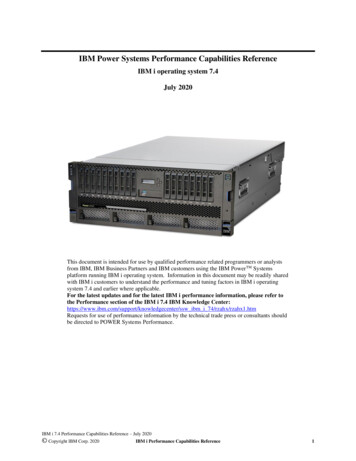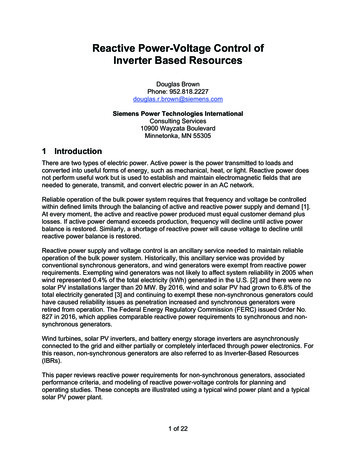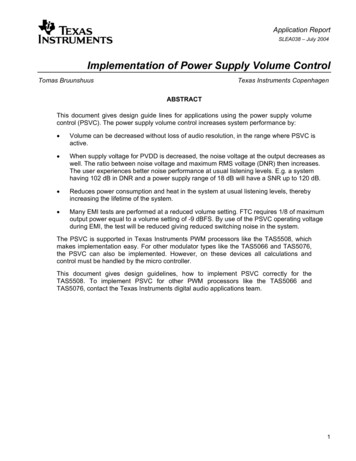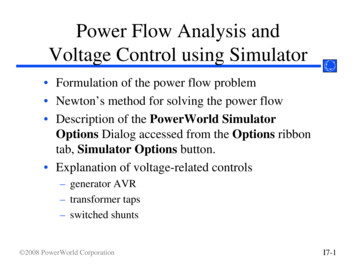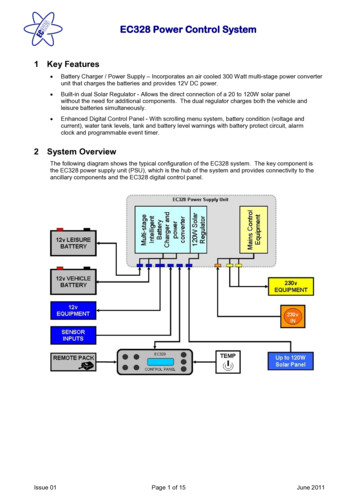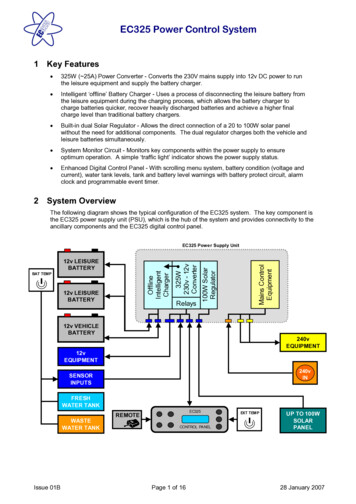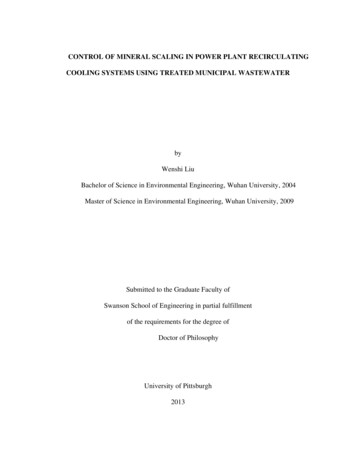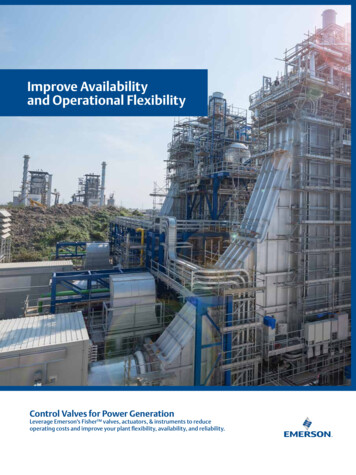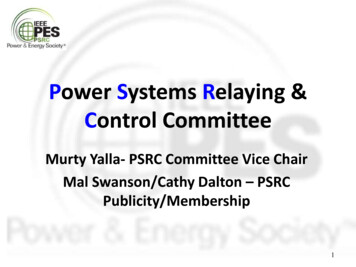
Transcription
Power Systems Relaying &Control CommitteeMurty Yalla- PSRC Committee Vice ChairMal Swanson/Cathy Dalton – PSRCPublicity/Membership1
The IEEE YesterdaySociety of Wirelessand Telegraph EngineersIRE1912WirelessCommunicationsIn the late 1800’sWireless Institute-telegraph-transcontinental undersea cable-arc and incandescent light-electrical equipment 31930Wire Communications,Light and PowerElectrical Exhibition, Franklin Institute, PhiladelphiaThe invention of the Electron VacuumTube blurs technical boundariesDetailed history can be found at the following -History-Presentation-RAD.pdf2
The IEEE Today 430,000 members in 160 countries. The world’s largest technical & professionalsociety. 1,400,000 subscribers to all IEEEpublications. 400,000 attendees at conferences annually. 40,000 participants in Standards.3
IEEE Mission & Vision4
IEEE Regions & 12/12IEEE Membership – 12/125
IEEE OrganizationThe IEEE is made up of 38 Societies 10 Councils Approximately 2,195 individual and joint Societychapters and 333 Sections 2,354 Student Branches are located at collegesand universities worldwide.6
Power & Energy Society (PES) The Power System Relaying & ControlCommittee is a Technical Committee in the PES PES is the third largest Society with 30,000members– Computer society 67k– Communications society 50k7
IEEE (38 Societies)Power & Energy Society (PES)(17 20 Committees)Power System Relaying and ControlCommittee8
2019 PES Technical CouncilCOUNCIL OFFICERSFarnoosh Rahmatian, ChairVijay Vittal, Vice ChairHong Chen, SecretaryMiriam Sanders, Past /technical-council9
2019 PES Technical CouncilTECHNICAL COMMITTEESAnalytic Methods for Power Systems Committee - Kevin Schneider, ChairElectric Machinery Committee - K. Chen, ChairEnergy Development and Power Generation Committee - John B. Yale, ChairEnergy Storage and Stationary Battery Committee - Curtis Ashton, ChairInsulated Conductors Committee - E. Bascom, ChairNuclear Power Engineering Committee - Daryl Harmon, ChairPower System Communications and Cybersecurity Committee - Ken Fodero, ChairPower System Dynamic Performance Committee - Costas Vournas, ChairPower System Instrumentation and Measurements Committee - E. Hanique, ChairPower System Operations, Planning and Economics Committee - L. Barrosso, ChairPower System Relaying and Control Committee - Russ Patterson, ChairSmart Buildings, Loads and Customer Systems - Shawn Chandler, ChairSubstations Committee - Joe Gravelle, ChairSurge Protective Devices Committee - Steven Hensley, ChairSwitchgear Committee - Todd Irwin, ChairTransformers Committee - Susan McNelly, ChairTransmission and Distribution Committee - G. Chang, technical-council10
Power System Relaying and ControlCommittee Meets 3 times a year (Jan., May & Sept.) Consists of 6 technical Subcommittees Typical attendance 220– 50 Utilities– 28 Manufacturers– 10 Universities– 20 Consulting organizations11
PSRC ScopeTreatment of all matters in which the dominant factorsare the principles, application, design, construction,testing, and operation of power system protection andcontrol. Protection and control systems include one ormore of the following functions:-- Sensing-- data acquisition and processing-- fault detection-- manual or automatic control-- and auxiliary operation12
PSRC Scope (Part 2)Included are: The devices providing these functions such asprotective relaying, regulating, monitoring,synchronism-check, synchronizing, and reclosing relays;transducers; and Intelligent Electronic Devices (IEDs). The functions employed in the generation,transmission, distribution, and utilization of electricalenergy, and their effects on system operation. The environmental phenomena that can adverselyaffect them.13
PSRC Scope (Part 3) The communication, cybersecurity, timesynchronization, and related requirements necessary tosupport protection and control systems, such as theidentification and declaration of object modeling,message sizes, latencies, and jitter for satisfyingtechnical and business requirements.14
PSRC Scope (Part 4) The scope includes liaison and cooperation withother technical committees, societies, groups andassociations concerned with various aspects of itemsherein.15
PSRC Officers - Main Committee Chairman – Russ Patterson - Patterson Power EngineersRepresents PSRC on the Technical Council– Sponsor of Standards Vice Chairman – Murty Yalla – Beckwith Electric– Technical Committee Paper Coordinator (GM & T&D Expo)– Chooses new meeting venues Secretary – Michael Thompson– Schweitzer Engineering Lab– Set meeting agenda– Records minutes– Runs physical meeting Standards Coordinator - Don Lukach– Ameren16
PSRC Subcommittees Advisory (ADCOM) – Russ PattersonSystems Protection – Gene HennebergLine Protection – Karl ZimmermanRelay Communications - Galina AntanovaRelay Practices and Consumer Interface – BrianMugalian Rotating Machinery Protection –Dale Finney Substation Protection – Jeff Barsch17
C: System Protection SubcommitteeScope: Evaluate protection system responses toabnormal power system states. Evaluate and report onspecial protection schemes, remedial actions schemes,monitoring and control systems and their performanceduring abnormal power system conditions. Recommendcorrective strategies and develop appropriate standards,guides, or special publications. Evaluate and report onnew technologies which may have a bearing onprotection system performance during abnormal powersystem conditions.18
D: Line Protection SubcommitteeScope: Investigate and report on the relaying techniquesand systems used for T&D line protection. Developstatistics and recommend protection practices forimproving line relaying performance. Develop andmaintain standards for line protection.19
H: Relay Communications andControl SubcommitteeScope: Evaluate and report on the characteristics andperformance of protective relaying communications andcontrol systems. Recommend communicationrequirements, operating and test procedures whichassure reliable performance of the overall protection andcontrol system. Report on new relaying equipmentdesigns tailored to specific communication requirements.20
H: Relay Communications andControl SC (Page 2)Included are matters necessary to the function of: such systems employed in the generation, transmission,distribution, and utilization of electrical energy, andtheir effects on system operation. Control systemsinclude data acquisition and processing from devicessuch as transducers, Intelligent Electronic Devices(IEDs), and Human Machine Interfaces (HMIs) includingthe low-level interfaces to these systems. Power System control issues associated with PowerSystem Dynamics are excluded from this scope.21
I: Relaying Practices SubcommitteeScope: Develop, recommend and establishstandards on protective relaying practices which arecompatible with the electrical environment,including, but not limited to, relay withstandcapabilities to electromagnetic interference,characteristics and performance of instrumenttransformers, testing procedures, applications,performance criteria, and definitions of relays andrelay systems.22
J: Rotating Machinery SubcommitteeScope: Evaluate and report on protective relayingconcepts and practices applicable to generators,motors, synchronous condensers, associatedauxiliary systems, and performance of plantprotective systems. Develop and maintain relatedrelaying standards.23
K: Substation Protection SubcommitteeScope: Evaluate and report on methods used inprotective relaying of substations and the consumeror independent power producer, associatedequipment and performance of these protectivesystems. Develop and maintain relaying standardswhich relate to this equipment and the utilityconsumer interface.24
What does the PSRC Committee Do ? Responsible for 55 IEEE Standards and Guides Standards have 10 year life Before the 10 years expires the standard must beupdated and balloted Technical paper review Write reports / papers25
Working Group Process Education– Speakers present topics pertinent to the standard– Working group member learn about topic– One reason to join working group Writing or rewriting– Members write various portions of the standard– Writing assignments are reviewed and revised Balloting– Ballot and resolve comments– 75% approval needed– Anyone can join balloting body– Must be an IEEE SA member to ballot26
Working Group Process Forward to IEEE SA for final approval andpublishing After Ballot is finished working group assignmentis complete Working group may publish– Transaction paper– Conference paper– Tutorial27
Membership Anyone can come and participateGuestWorking Group memberSubcommittee memberMain Committee member28
BENEFITS OF PSRC ATTENDANCEIMPROVE PRACTICES: Learn about and influence standards thatdirectly effect your designs. Gain advance knowledge on future guidesand standards. Best practice sharing with other utilities,consultants and suppliers. Highlight your Company’s expertise andbest practices.29
Benefits of PSRC AttendanceNetworking: With suppliers: Know key personnel from yoursuppliers. With consultants: Identify consultants that meetyour requirements. With other utilities: Acquire key personnelrecruiting ideas and personal contacts30
Meeting Organization Monday evening reception Tuesday – all day working group meetings Wednesday morning – working groupmeetings Wednesday afternoon – Subcommittee Mtgs Thursday - Main Committee Meeting WG meetings intersperse with Power SystemCommunications and Cybersecurity groups31
QUESTIONS ?http://pes-psrc.org/32
Switchgear Committee - Todd Irwin, Chair Transformers Committee - Susan McNelly, . Intelligent Electronic Devices (IEDs), and Human Machine Interfaces (HMIs) including the low-level interfaces to these systems. Power System control issues associated with Power System Dynamics are excluded from this scope. 21 Included are matters necessary to the function of: I: Relaying Practices .
